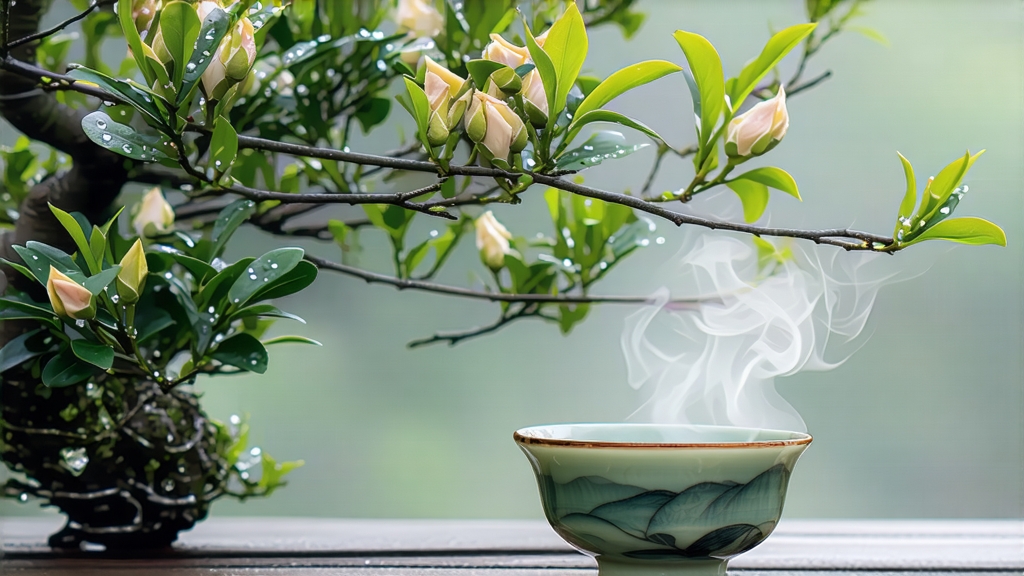
If green tea is the exuberant youth of Chinese tea and pu-erh its contemplative elder, then Fuding White Needle (Bai Hao Yin Zhen) is the moonlight that slips between them—luminous, weightless, and quietly eternal. Revered since the Song dynasty yet still little-known outside specialist circles, this northern Fujian specialty offers the clearest lens through which to understand why Chinese connoisseurs speak of “tea as living history.” From the first imperial tribute lists of 1064 CE to the modern auction blocks of Shanghai, White Needle has remained the benchmark against which all other white teas are measured. Its story is one of geology, weather, patience, and an almost monastic restraint in both garden and teahouse.
Geography writes the first chapter. The small coastal county of Fuding lies at 27° N, where the East China Sea’s fog meets the granite spines of the Wuyi foothills. Day-night temperature swings of 10 °C force the tea bush (Camellia sinensis var. sinensis, Da Bai cultivar) to hoard amino acids in its dormant winter buds. When the first thermometers climb above 15 °C—usually between mid-March and early April—those buds swell into inch-long spears sheathed in fine white down. Locals call the down “silver dust,” and its density is the first quality metric: the more reflective the bud, the higher the concentration of protective catechins and volatile terpenes that will later translate into honeyed aroma.
Plucking is a race against the sun. Pickers enter the garden before dawn wearing woven bamboo hats whose brims are deliberately wide enough to shade the basket. Only the unopened bud—never the adjacent leaf—is snapped sideways with the thumbnail, a motion that severs the stem without bruising cellular walls. Experienced hands harvest roughly 2,000 buds per hour, yet it still takes 30,000 of them to yield a single 500 g tin. Because mechanical shears would oxidize the cut surface within seconds, White Needle remains one of the last major teas still picked entirely by hand.
Withering is where science and poetry converge. Traditionally the buds are laid on bamboo trays stacked like organ pipes in a sun-lit corridor whose windows face southeast to catch the maritime breeze. For 36–48 hours they lose moisture in slow motion, while enzymatic oxidation hovers at 5–8 %. Modern producers supplement nature with climate tunnels set to 26 °C and 65 % humidity, yet the goal is the same: to let the leaf “read its own memory” of sea mist and mountain chill. Master tea makers judge readiness not by moisture meters but by the sound a bud makes when rolled between the palms—what they describe as “the sigh of a sleeper turning over.” When that sigh softens into a near-silent hush, the buds are moved to a charcoal-warm loft for a final desiccation at 40 °C, low enough to preserve the enzyme profile yet high enough to fix the silvery color.
The finished tea is visually unmistakable: slender needles the color of polished pewter, each tipped with a tiny fish-hook curve where the bud once clung to the branch. The aroma is subdued, almost coy, revealing itself only after a gentle warmth is introduced. Then comes a spectrum Western tasting wheels struggle to name: wet limestone, lychee peal, fresh alfalfa, and something oceanic—like the breath that rises off a tidepool at dawn.
Brewing White Needle is an exercise in restraint. Because the leaf is minimally processed, it is hypersensitive to both water chemistry and heat shock. Start with low-TDS spring water; anything above 80 ppm of minerals will muffle the high-register aromatics. Heat the water to 85 °C, then wait thirty seconds until it falls to 80 °C. Use a porcelain gaiwan of 100 ml capacity; its thermal inertia protects the buds from temperature cliffs. For the first infusion, flash-brew: add 3 g of needles, flood with water, and decant within five seconds. This “awakening rinse” is not discarded but poured into the fairness pitcher and then into cups, allowing drinkers to calibrate their palates to the tea’s quietest register. Subsequent infusions lengthen in five-second increments: 5, 10, 15, 25, 40,